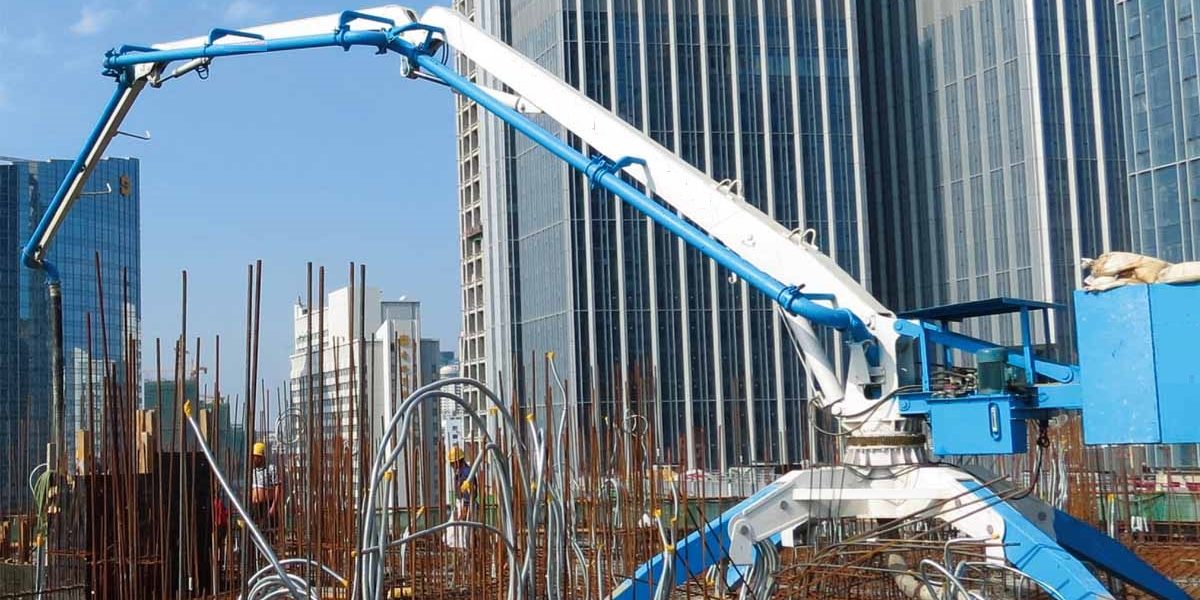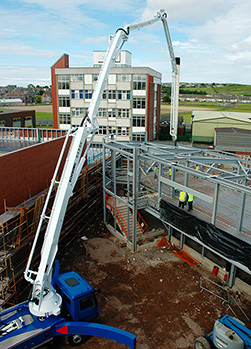 Other than capacity, the main difference between the various types of concrete pumps is determined by the additional equipment that comes as part of the pump. A concrete pump in its simplest form is best represented by a Stationary Concrete Pump. Additions to this, resulting in other types of concrete pump are:
Other than capacity, the main difference between the various types of concrete pumps is determined by the additional equipment that comes as part of the pump. A concrete pump in its simplest form is best represented by a Stationary Concrete Pump. Additions to this, resulting in other types of concrete pump are:
- Transport – a dedicated vehicle to transport and position the pump,
- A Boom – a dedicated placing boom attached to the pump,
- and even a Truck Mixer – to store and supply the concrete.
Mobile Pump
A Mobile Concrete Pump, also known as a Truck Mounted Mobile incorporates both a concrete pump and a placing boom mounted onto a truck chassis. Mobiles come with booms ranging from less than 20 metres to ones which can reach heights of over 60 metres. The advantage of a mobile pump is that it can turn up at a job and be pumping concrete very quickly to anywhere within the range of the boom. This makes mobile boom pumps very popular on the widest range of construction projects, being able to pump at very high volumes quickly to wherever concrete is needed with minimum labour requirements.
Stationary Pump
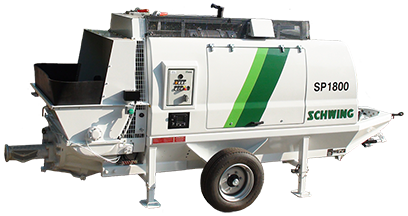
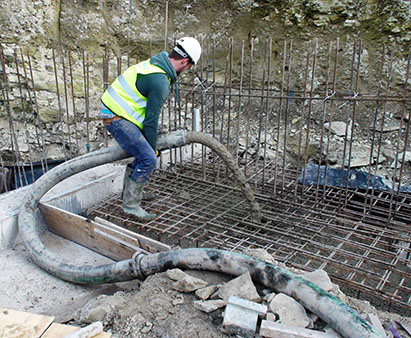 A Static Concrete Pump, also referred to as a Stationary, Line Pump or Trailer Mounted Concrete Pump is mounted on a trailer and requires separate pipeline to be attached reaching to wherever the concrete needs to be placed. The pipeline is a series of steel or rubber pipes, known also as concrete placing hoses, linked together and manually attached to the outlet of the pump. The other end of the pipe could either be attached to a Separate Placing Boom, allowing the concrete to be placed with precision quickly over a wide area or it might just finish with a rubber placing hose for manual placement. A Static Pump needs to be towed or separately transported to jobs.
A Static Concrete Pump, also referred to as a Stationary, Line Pump or Trailer Mounted Concrete Pump is mounted on a trailer and requires separate pipeline to be attached reaching to wherever the concrete needs to be placed. The pipeline is a series of steel or rubber pipes, known also as concrete placing hoses, linked together and manually attached to the outlet of the pump. The other end of the pipe could either be attached to a Separate Placing Boom, allowing the concrete to be placed with precision quickly over a wide area or it might just finish with a rubber placing hose for manual placement. A Static Pump needs to be towed or separately transported to jobs.
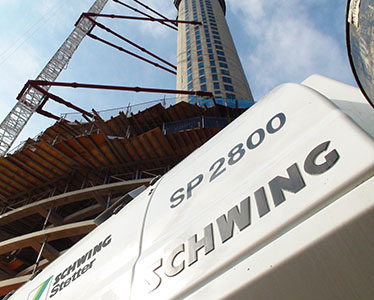 The advantage of a static pump is that the pipeline can be long so that the actual pump can be very far away from where the concrete is being placed; maybe hundreds of metres below or even kilometres away. This makes static pumps essential for tunnelling work and high rise constructions. Static Concrete pumps come in a far greater range of capacity than those used on Mobile pumps. From smaller pumps ideal for residential and low rise work right up to the SP8800 which can reach pressures up to 243 bar and pump over 100m³ per hour. It is a middle of the range SP4000 which holds the World Record for pumping concrete to the highest vertical distance. (The job also included a horizontal component of over 1km.) A pumping distance has yet to be found which cannot be done by a Schwing pump.
The advantage of a static pump is that the pipeline can be long so that the actual pump can be very far away from where the concrete is being placed; maybe hundreds of metres below or even kilometres away. This makes static pumps essential for tunnelling work and high rise constructions. Static Concrete pumps come in a far greater range of capacity than those used on Mobile pumps. From smaller pumps ideal for residential and low rise work right up to the SP8800 which can reach pressures up to 243 bar and pump over 100m³ per hour. It is a middle of the range SP4000 which holds the World Record for pumping concrete to the highest vertical distance. (The job also included a horizontal component of over 1km.) A pumping distance has yet to be found which cannot be done by a Schwing pump.
Truck Mounted Static Pump
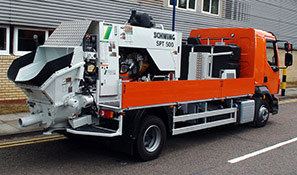 A static pump can also be mounted onto a truck chassis but without a boom, resulting in a Schwing Truck Mounted Static Concrete Pump. These are perfect for the many quick jobs where a boom might not reach. It might be a slab for an extension at the back of a home or garden where running a pipeline through or round the building is the only option. A normal static pump would need to be towed or delivered on a Hiab truck but with the Truck Mounted Static Pump, the operator can drive it straight to site. Schwing Truck Mounted Static Pumps also come with storage for up to 100 meters of pipeline and other accessories so everything needed is in one place allowing the operator to pack up and head straight to the next job as soon as a work is completed.
A static pump can also be mounted onto a truck chassis but without a boom, resulting in a Schwing Truck Mounted Static Concrete Pump. These are perfect for the many quick jobs where a boom might not reach. It might be a slab for an extension at the back of a home or garden where running a pipeline through or round the building is the only option. A normal static pump would need to be towed or delivered on a Hiab truck but with the Truck Mounted Static Pump, the operator can drive it straight to site. Schwing Truck Mounted Static Pumps also come with storage for up to 100 meters of pipeline and other accessories so everything needed is in one place allowing the operator to pack up and head straight to the next job as soon as a work is completed.
Truck Mixer Concrete Pump
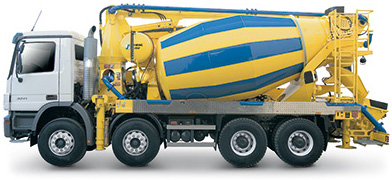 Another aspect of concrete placement is the supply of concrete. Both Mobile and Static Pumps have a large hopper to receive concrete from a truck mixer. However Schwing Stetter offers a mobile product which also carries a supply of concrete with it. The Fahrmischer Beton Pumpen (truck mixer concrete pump) combines not only a pump and boom but also the concrete storage and transport in the form of a mixer truck, all in one package.
Another aspect of concrete placement is the supply of concrete. Both Mobile and Static Pumps have a large hopper to receive concrete from a truck mixer. However Schwing Stetter offers a mobile product which also carries a supply of concrete with it. The Fahrmischer Beton Pumpen (truck mixer concrete pump) combines not only a pump and boom but also the concrete storage and transport in the form of a mixer truck, all in one package.

